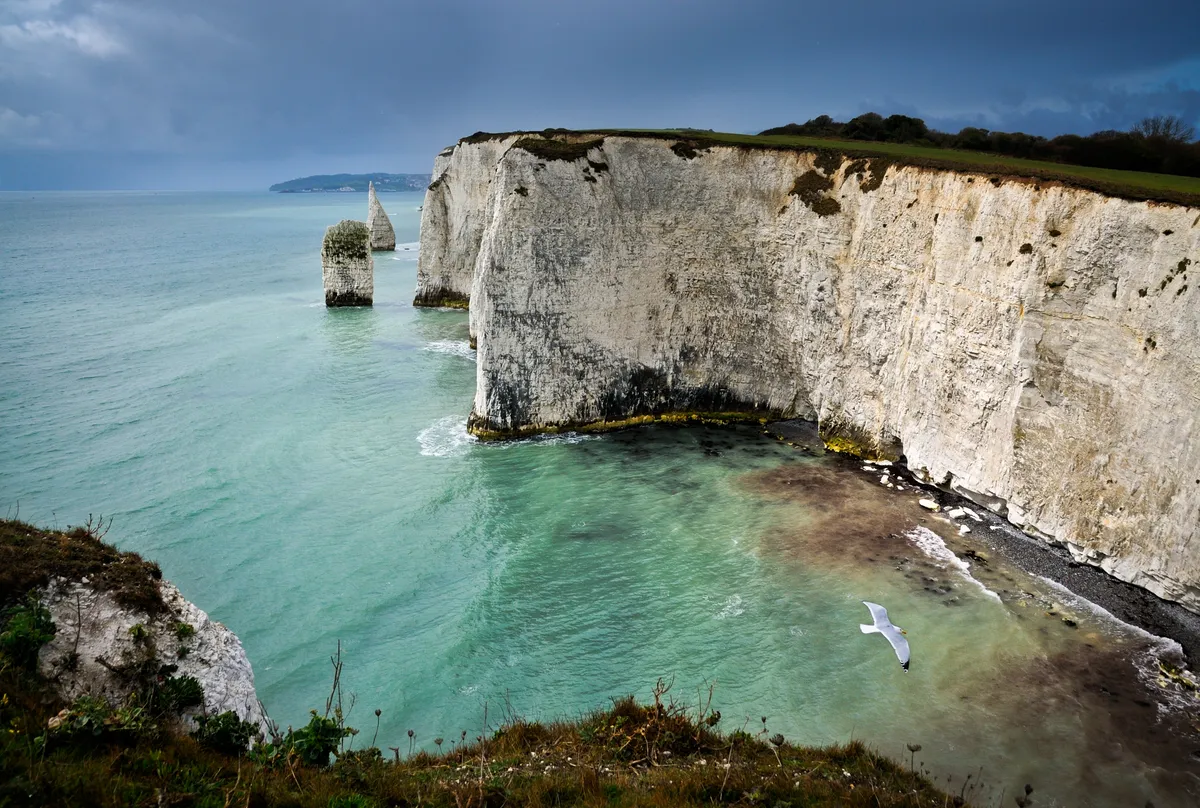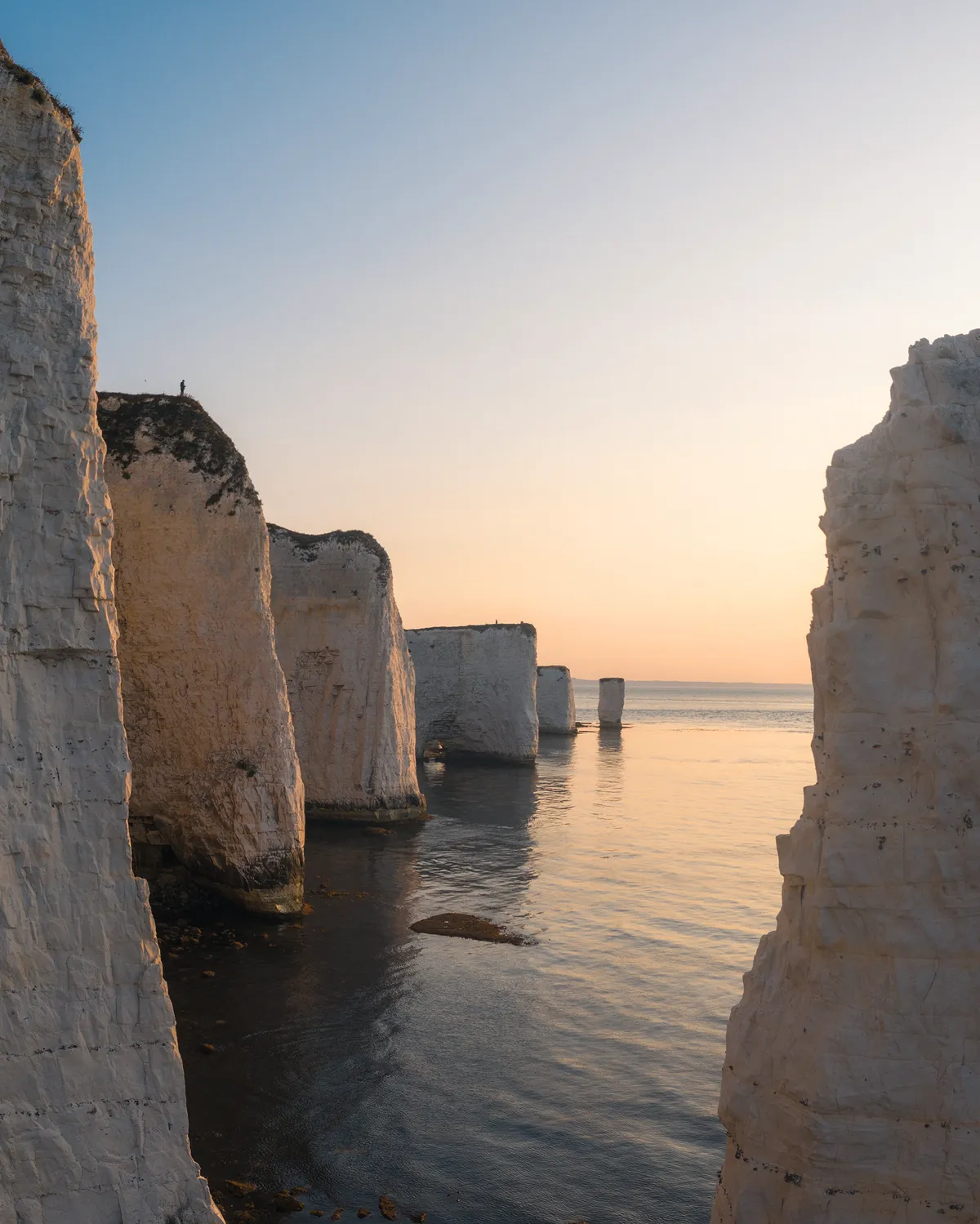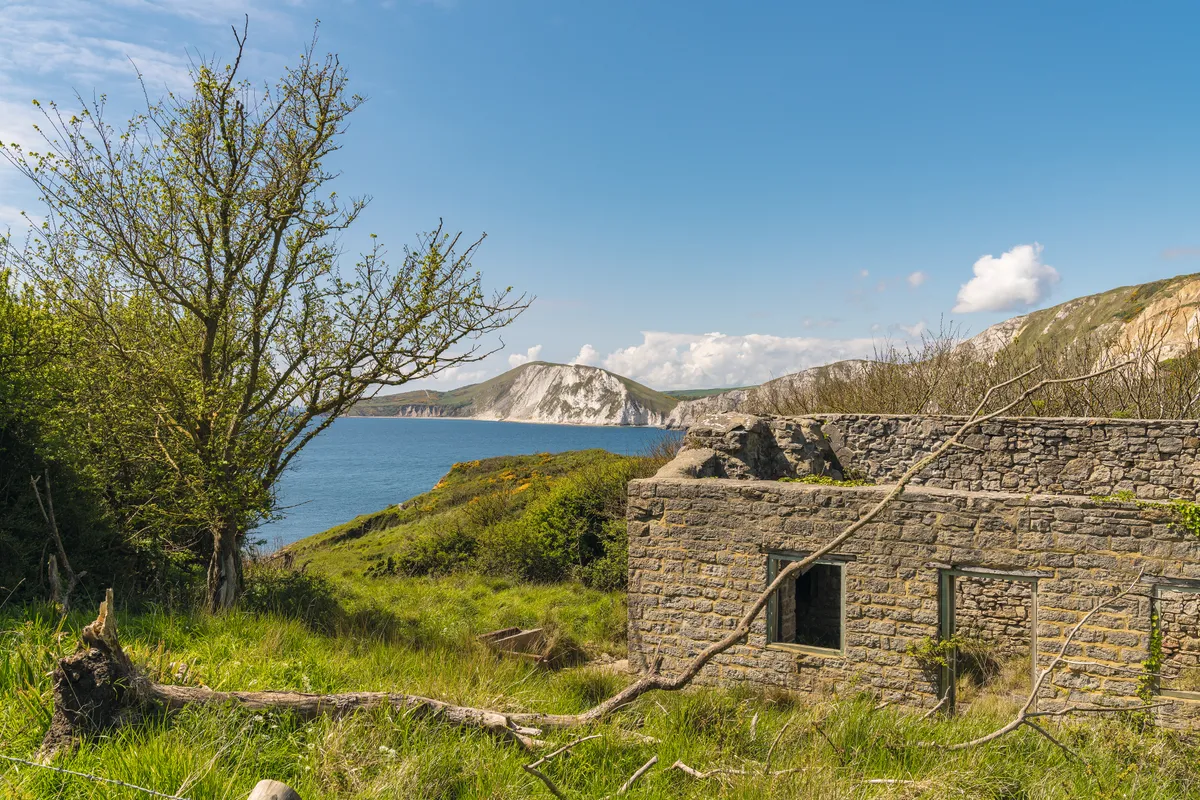Purbeck in Dorset is a place of sandy heaths, water meadows, chalk downland rich with wild flowers, rocky landmarks, small limestone quarries, ancient field systems and dunes. Any walk or drive to higher ground will be rewarded by panoramic sweeping views of the coast, inset by deep rocky valleys and narrow chines (or gorges) and often ending in dramatic cliffs, coastal caves and stacks.
On the more boggy northern side, a super nature reserve includes wetlands, heath and scrub. There are a few coppiced woods inland and smaller farms with fields divided often by drystone walls. Grazing cattle include Red Devon cows, which in some places wander free-range among the ponies and the pigs. Winding lanes lead from one lovely village to the next, with ivied inns and pretty stone-roofed cottages made from the ash-coloured Purbeck stone taken from the numerous quarries, many still in operation.
In the middle of Purbeck is the picturesque ruin of Corfe Castle, standing on a chalk hill beside the main gap in the Purbeck Ridge. And the central plateau, covered with grassland, can be either windswept and bracing, or warm and tranquil, depending on when you time your visit.
Plan your visit to Purbeck with our expert travel guide, plus if you're after more inspiration we've gathered our pick of the best walks in Dorset and a local travel guide to Dorset.

Is the Isle of Purbeck an island?
The Isle of Purbeck is not actually an isle at all, although it is bordered on three sides by water: in the north by Poole Harbour – formed naturally from a flooded valley – and in the south and east by the English Channel. Inland, the boundary is less distinct, although you might stretch a line from Durdle Door across to Wareham and so include the villages of Lulworth, Studland, Worth Matravers and Corfe Castle, and the town of Swanage.
Where is Purbeck?
Purbek is a peninsula located on the Dorset coast. The South West Coast Path ends (or starts) at Purbeck, beside a chain ferry that brings visitors across from Sandbanks, while the chalk cliffs and stacks of Old Harry Rocks are the eastern end of the Jurassic Coast, a UNESCO World Heritage Site that begins 95 miles away at Exmouth in Devon. A chalk ridge runs east to west across Purbeck, forming a dividing line between the heaths and wetlands to its north and the pastures and dramatic cliffs in the south.
Check out our guide to the Jurassic Coast.
Best beaches in Purbeck
Studland Bay, with its golden sand and gently shelving beaches, was where I took my children when they were young. Four miles long, the bay holds four beaches: Shell Bay, adjacent to the ferry; Knoll Beach, the longest, with a naturist area (if you dare); Middle Beach, with a café and watersports available; and the smallest, South Beach, cut off from the others at high tide but with wonderful views of Old Harry. The waters here have been designated a Marine Conservation Zone, helping to restore the native seagrass meadows in which endangered spiny seahorses live.
Beyond Old Harry the white cliffs continue to Swanage and beyond, but here, the sea has scooped out large-pebbled coves, including Chapmans Pool, Kimmeridge Bay and Warbarrow Bay – all excellent spots for fossil hunting.

Following the coast further west you come to Lulworth Cove and Stair Hole with the famous Lulworth Crumple – a section of folded and toppled limestone strata – and, finally, to Durdle Door, an iconic limestone arch jutting into the sea. Nearly all of these coves and bays are accessible either via nearby car parks or on foot, and all are swimmable, wetsuit or not. There is even the Kimmeridge Snorkel Trail – a route of five buoys that leads confident swimmers through a variety of seabed habitats. And, of course, if you haven’t brought your cossie, there’s always the joy of rockpooling.
We included Corfe Castle in our round-up of Britain's best picnic spots.
Historical sites in Purbeck
With its secluded coves, Purbeck’s coast used to be a haven for smugglers, but other, perhaps more reputable folk also inhabited the area. Corfe Castle has dominated the route from Wareham to Swanage for more than 10 centuries and is now owned by the National Trust. William the Conqueror began its construction and various other monarchs made their mark on it until it was all but destroyed by Cromwell’s Parliamentarians in 1646.
Purbeck has other Norman treasures, including St Nicholas, Studland’s church, with its rather naughty Norman carvings of a copulating couple and a sheela na gign (a stylised nude), while on St Aldhelm’s Head, you can view a tiny Norman
chapel and its 17th-century graffiti.
Other, more recent, history can be seen across the landscape, including the ‘lost’ village of Tyneham, which was evacuated in 1943 and has been deserted ever since. Today, two buildings have been restored and the village is open to the public at weekends and throughout August. It’s an eerie experience walking around this ghost village; you can combine your visit with the mile or so walk down to Warbarrow Beach.

Purbeck’s military past is also evident at Studland, where you can look out through the viewing hole of Fort Henry, a concrete observation bunker, to see where Churchill, Eisenhower, Montgomery and George VI watched military exercises in preparation for D-Day.
The wildlife of Purbeck
Rich with wildlife, Purbeck is the most botanically diverse area of its size in the UK, home to 44 of the 58 species of mammals that reside on British shores. In the autumn, the National Trust offers guided walks to see the red squirrels on Brownsea Island, the largest of the many islands in Poole Harbour, which can be accessed via a ferry from Poole Quay.
If you’re lucky, you might also get to see a white-tailed eagle or an osprey, following a successful reintroduction programme that began in the harbour in 2017. These birds have also been spotted at RSPB Arne Nature Reserve, one of the few places with all six of the UK’s native reptiles, as well as spoonbills, nightjars, Dartford warblers and sika deer. Arne covers 565 hectares
of heathland, wetland, reedbeds, mudflats and oak woodland and is a wonderful place for a walk, especially if you prefer to follow marked trails.
The list of other animals and species that you can spot on Purbeck goes on: butterflies such as the Lulworth skipper and Adonis blue, and wildflowers including the scarce early spider orchid. Purbeck is also home to 15 of Britain’s native bat species, and Winspit Quarry, on the southern coast, is Dorset’s most important swarming site.
The flourishing wildlife on Purbeck adds to the feeling that this special place is somehow out of sync with the modern world beyond. The Purbeck I found on my return in many ways felt little changed, somehow managing to keep its dreamy timelessness – while leading the way in supporting and renewing its beautiful landscapes, stunning coastline and wide variety of animals and plants. You can be sure I won’t leave it another 40 years before I visit again.
Did you know?
We included a place in Purbeck in our list of Britain's rudest and funniest place names...
Purbeck's heathlands
Two years ago, a super National Nature Reserve (NNR) was created when seven organisations and agencies joined together to connect three smaller reserves, forming a mostly heathland area of more than 3,200 hectares. These precious heathlands are made up of a range of vegetation types, including dry and wet heath (dominated by heathers), acid grassland, trees, scrub, bracken and bogs, all of which means they can support a wide range of mammals, insects, birds and plants. If you’re lucky, you might see one of the sand lizards (inset) that were released into Coombe Heath in 2007.
Purbeck ice cream
Founded in 1988, Purbeck Ice Cream is one of the primary exports from the area – and one of the reasons why the name 'Purbeck' is familiar to so many of us! The family-run business uses 60% Purbeck milk and 22% Dorset cream to create their unique ice cream recipes. The company is based in Kingston, a small village on the Isle of Purbeck.
